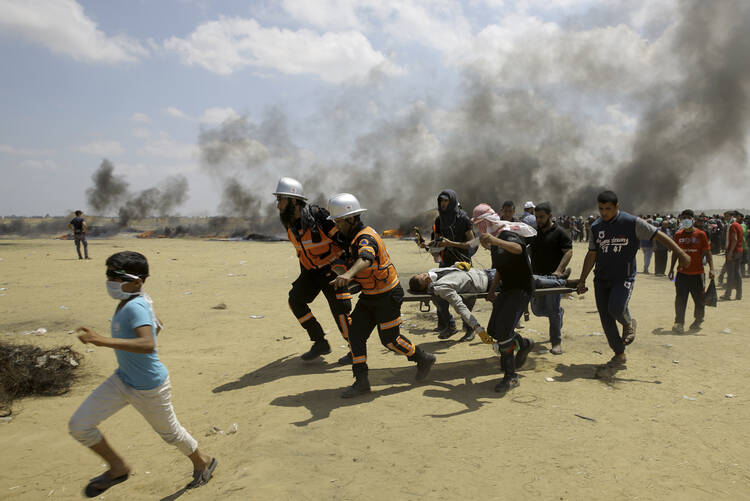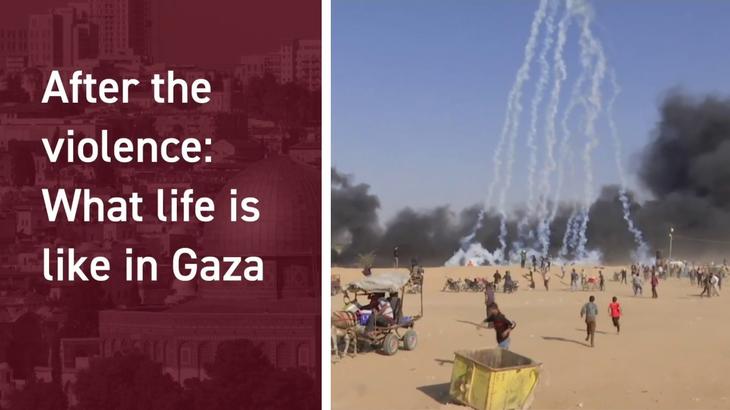This week Israelis celebrated the 70th anniversary of the founding of their state with the move of the United States Embassy from Tel Aviv to Jerusalem, and Palestinians marked the 70th anniversary of their dispossession, the Nakba, or “Catastrophe,” the forced exile of an estimated 700,000 Palestinians from their homes in what had been the British Mandate for Palestine.
It is a tragic story of one Semitic people driving another from the villages that their ancestors had occupied, the fields they had cultivated and the pastures they had tended for millennia. In Arabic, the word for Palestinians is Filastini, the same tribe (Philistines) that occupied the coastal plain of Canaan prior to the biblical conquest of the land by the ancient Hebrews and whose giant-hero Goliath was slain by the youth David.
Early Israeli propaganda led many to believe that the Palestinians who fled what was about to become Israel escaped the territory of their own choice in panic at being left behind Israeli lines. But Israel’s New Historians, scholars like Benny Morris, Avi Shlaim and Ilan Pappe, have shown that they were driven from their homes and villages in a premeditated, systematic military campaign.
Systematic Expulsion
In Plan Dalat, a design for conquest of the new land of Israel, Hagganah, the Jewish resistance group under the leadership of David Ben Gurion, called for the forced expulsion of Palestinians from their urban neighborhoods and more than 400 villages in the hope of securing the Zionist victory and of winning greater territory than what had been designated by the U.N. Partition Plan for the new Israeli state. Expulsion, they believed, was essential to military planning for control of the land.
The deaths of over 60 protesters and the wounding of a more than 2,000 more only emphasized the cheapness of Palestinian life in Israeli eyes.
According to Ilan Pappe, “The aim of the plan was in fact the destruction of both rural and urban areas of Palestine.” Explicit orders were given at the operational level for the villages and urban neighborhoods that “had to be occupied, destroyed, and their inhabitants expelled.”
Today, Zochrot, an Israeli N.G.O., which preserves the memory of the depopulated Palestinian areas, lists 601 destroyed villages in what is now Israel and 194 in Syria. Refugees fled to the West Bank, Jordan, Egypt, Syria, Lebanon and Gaza.
The refugees were not welcomed everywhere. Only in Jordan and Syria were they allowed more or less to integrate into society. Today, there are more than four million Palestinian refugees, many still living tenuously in camps, temporary housing, really, on the West Bank and in Gaza, Jordan and Lebanon. Others, both day workers and professionals, work without the protections of citizenship in the Gulf states. Palestinians are a people dispossessed.
The Right of Return
The ostensible cause around which Hamas organized the six weeks of protest in Gaza prior to the Nakbacommemoration was the right of return, a claim Palestinians have long made but which Israel has continuously rejected. The right to return is enshrined in the Universal Declaration of Human Rights and several modern treaties, including the Fourth Geneva Convention. The latter permits the mass removal of populations “if the security of the population or imperative military reasons so demand” but enjoins their return once hostilities have ended. Explicit authority for the Palestinian right of return is found in U.N. General Assembly resolutions 194 and 242.
The right of return has long been regarded as a necessary component of a final peace settlement. The Madrid Process, following the U.S.-led coalition victory in the First Gulf War (1991), organized one of five multilateral negotiations on the refugee question, but Israel refused to join that negotiation. Under the 1993 Oslo Accords, the refugee question was to be a final status issue, that is, a matter addressed after the general outline of an agreement had been reached.
The refugee issue was taken up at the Camp David II talks, led by U.S. president Bill Clinton in 2000, but overall agreement was not reached, in part, because the Palestinian delegation had not prepared the Palestinian diaspora for an agreement in which major concessions would be made to Israel in which the vast majority of refugees would either be given support in their current host countries or resettled in third countries.
At the time of Camp David, Palestinian advisers explained they expected only 500,000 refugees would be resettled in a new Palestinian state—over 10 years—and just 100,000 permitted to return to Israel. That would mean that the vast majority of Palestinian refugees would either have to receive permanent residence in their host countries or accept resettlement to a third country. Both options would require substantial financial support from the international community.
The Gaza Nakba demonstrations this week have done nothing to advance the situation of Palestinian refugees, nor did they provide relief to the people of Gaza, who dwell in an open-air prison, hemmed in and oppressed at every turn. Hamas’s turn to tactical nonviolence mixed with acts of provocation at the border did little to focus the world’s attention on Palestinian rights. The deaths of over 60 protesters and the wounding of a more than 2,000 more only emphasized the cheapness of Palestinian life in Israeli eyes. It was a dispiriting outcome for everyone—Palestinians, Israelis and concerned outsiders.
Needed Responses
Hamas’s inability to capture the world’s attention for Palestinian refugees should not deter the world community from addressing their needs, however. The most urgent need is financing for the United Nations Relief and Works Agency for Palestine, which supports hospitals, schools, social services and housing for five million Palestinian refugees in the region. The United States has been the largest donor to the agency. But the Trump administration first cut the U.S. commitment from $355 million donated in 2017 to $125 million for 2018 and then withheld $65 million of that out of displeasure over Palestinian criticism of its decision to move the U.S. embassy to Jerusalem. A new Congress in 2019 might offer an opportunity for the United States to reassert its role as a responsible donor.
Second, a high-level U.N. meeting in September is scheduled to consider a Global Compact on Refugees and Migrants. That will be the occasion to raise up the plight of the world’s longest-lasting refugee group with an opportunity to project long-term solutions to their forced exile from their ancient homeland. Justice for refugees begins with justice for the Palestinians.
The church has repeatedly affirmed “the identical fundamental right” of Israelis and Palestinians “to have their own homeland in which to live in freedom, dignity and security in harmony with their neighbors.” The compact ought to give impetus to the prompt realization of the territorial integrity of the Palestinian State.
But, acknowledging the improbability of all the Palestinian exiles finding homes in Palestine, the world summit also ought to lay the foundations for the resettlement of others in their host countries or in hospitable third countries. The task will not be finished in September, but it ought to begin.












Is this true or is it misleading? Were they forced out or did they leave voluntarily. Are the people in Gaza originally from what is now Israel? Or from some other place? How are the Arabs/Muslims treated that remained in Israel vs Arabs in other countries?
This is made very clear in the article. They were forced to leave. The people (aka Palestinians) in Gaza, as in the West Bank and the non-occupied areas of the mid-east mentioned in the article did originally come from the territory currently known as Israel and the occupied territories. The treatment of the Israeli Palestinians is irrelevant here: the issue is the treatment of the people in Gaza which is indeed much worse than those in other places in the middle east.
Is this true? There are 1.6 million Arab Muslims living in Israel. Why/How are they there? The author should know this.
From what I understand about 700,000 left voluntarily primarily from other parts of Israel. 350,000 stayed. The people in Gaza are some refugees but were mostly there and Egypt does not want them. They have a border with Egypt. Hamas is the problem. If they recognized Israel and stopped the fighting it would get much better quickly.
No, it actually would not, because of the Zionist “Price Tag” Killers, and the American “Dispensationalists”. PLEASE consider more credible sources than the pro-Zionist, propagandistic American media:
https://www.youtube.com/watch?v=Fo77sTGpngQ&feature=youtu.be
https://www.youtube.com/watch?v=7NMwohMhP10&feature=youtu.be
https://www.doctorswithoutborders.org/article/gaza-avoiding-greater-blood-bath
https://www.theguardian.com/news/2018/may/18/a-suicide-in-gaza?CMP=share_btn_fb
https://blogs.spectator.co.uk/2018/05/the-israeli-rights-allies-are-no-friends-of-jews/
https://www.theguardian.com/commentisfree/2018/may/16/proud-israeli-want-peace-killing-gazans
And, if you really do believe that peace would just come to Israel if the Palestinians were to "recognize Israel as a Jewish State," you need to read THIS--carefully: https://www.theguardian.com/commentisfree/2018/may/20/the-fight-to-define-the-very-essence-of-israel
Thanks for the continued interesting articles on Gaza and the Palestinian situation. It is a good example of America presenting a perspective not generally seen in the general media.
No Drew, the Eastern European/Russian Jews have absolutely zero right to confiscate and settle on the land of the Palestinians. No more right than I have, buttressed by wealthy, well-armed, well-connected supporters, to take over the Jesuit property in Manhattan and send its present occupants packing. Your penultimate paragraph is in need of a heavy infusion of the concept of Justice as it applies to the Palestinian people in the 20th/21st centuries.